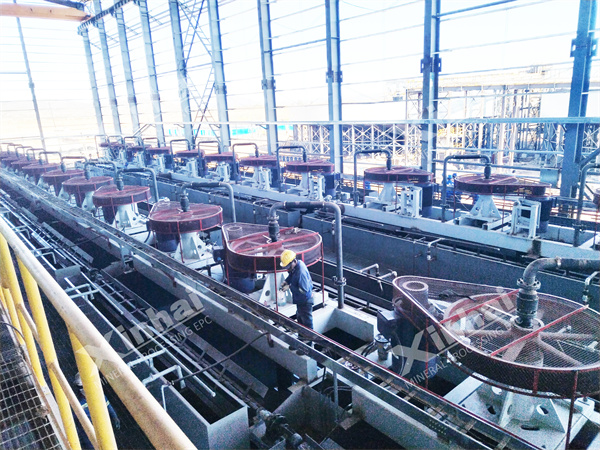Fluorite ore is an important industrial mineral widely used in steel smelting, chemical production, building materials manufacturing, and other fields. With the mining of high-grade fluorite ore, extracting CaF2 from low-grade fluorite ore has become an important means. The most common type of fluorite ore is low-grade fluorite ore containing quartz, which is difficult to beneficiation. This article analyzes the properties of the ore sample and determines the beneficiation method and flotation reagent dosage through beneficiation experiments. Let's take a look at this case together.
(1) Mineral composition
The low-grade fluorite ore sample used in the research institute was collected from a mining area in Inner Mongolia, and its main mineral composition is fluorite, quartz, feldspar, calcite, and a small amount of clay minerals. Fluorite, as the main useful mineral, has a content of about 30%, while quartz, as the main vein mineral, has a content of over 40%.
(2) Chemical composition
Through chemical analysis of the raw ore, it was found that its main chemical components are CaF2, SiO2, CaCO3, Al2O3, etc. Among them, the CaF2 content is low and the SiO2 content is high, which poses a challenge for the subsequent beneficiation process.

(1) Sample preparation
The preparation of laboratory scale samples is a prerequisite for ensuring the accuracy of mineral processing experiments. Firstly, the large pieces of ore are crushed, and then the ore is crushed to the appropriate particle size using equipment such as jaw crushers and roller crushers. Finally, representative samples are obtained through screening, mixing, and other steps.
(2) Determine grinding fineness
Grinding is an important preparation step before flotation. By adjusting the grinding fineness, the flotation effect can be significantly affected. This study determined through grinding fineness experiments that the optimal grinding fineness is -200 mesh, accounting for 80%.
(3) Adjust the temperature of the slurry
The temperature of the slurry has a significant impact on the dispersion and adsorption of flotation reagents. Through the flotation slurry temperature test, it was found that the best flotation effect can be achieved when the slurry temperature is controlled at 30 ℃.
(4) Dosage of collectors and adjusters
The dosage of collectors and adjusters is a key factor affecting flotation efficiency. This study selected oleic acid as the collector, carboxymethyl cellulose and sodium carbonate as the adjusters, and determined their optimal dosages of 150g/t and 300g/t through single factor experiments.
(1) Flotation process
Through a series of conditional and comprehensive experiments, the suitable flotation process was ultimately determined to be a closed circuit process consisting of one coarse selection, six fine selections, and centralized return of intermediate ores.
One coarse selection: This is the initial stage of the entire flotation process, with the goal of initially separating useful minerals from gangue minerals in fluorite ore. At this stage, the slurry is mixed with an appropriate amount of collector to form hydrophobicity on the surface of useful minerals (such as fluorite), which then adheres to bubbles and floats to the surface of the slurry, achieving preliminary separation from gangue minerals.
Six rounds of selection: After rough selection, the concentrate is further selected multiple times to improve its grade. Each selection is carried out under optimized conditions, further separating useful minerals and gangue minerals by adjusting the dosage of collectors and adjusters. During the selection process, the grade of the concentrate gradually increases and the impurity content decreases.
Centralized return of intermediate ore: The intermediate ore generated during the roughing and beneficiation processes is collected and returned to a certain point in the flotation process at an appropriate time (usually in the roughing or beneficiation stage). This approach can maximize the recovery of useful minerals and reduce resource waste.
(2) Analysis of flotation effect
By optimizing the flotation process parameters, this study successfully improved the sorting efficiency of low-grade fluorite ore. Under optimal process conditions, the grade of fluorite concentrate can reach over 98%, and the recovery rate can reach over 88%.
Compared with traditional beneficiation methods, the beneficiation technology adopted in this study not only improves sorting efficiency but also effectively reduces production costs. Especially by using carboxymethyl cellulose instead of water glass as an adjusting agent, the cost of the medication has been further reduced.
This study focuses on low-grade fluorite ore containing quartz, and successfully developed an effective beneficiation method through laboratory scale beneficiation experiments. This method significantly improves the grade and recovery rate of fluorite concentrate by optimizing process parameters such as grinding fineness, flotation slurry temperature, and the dosage of collectors and adjusters. It has lower production costs and better industrial application prospects.